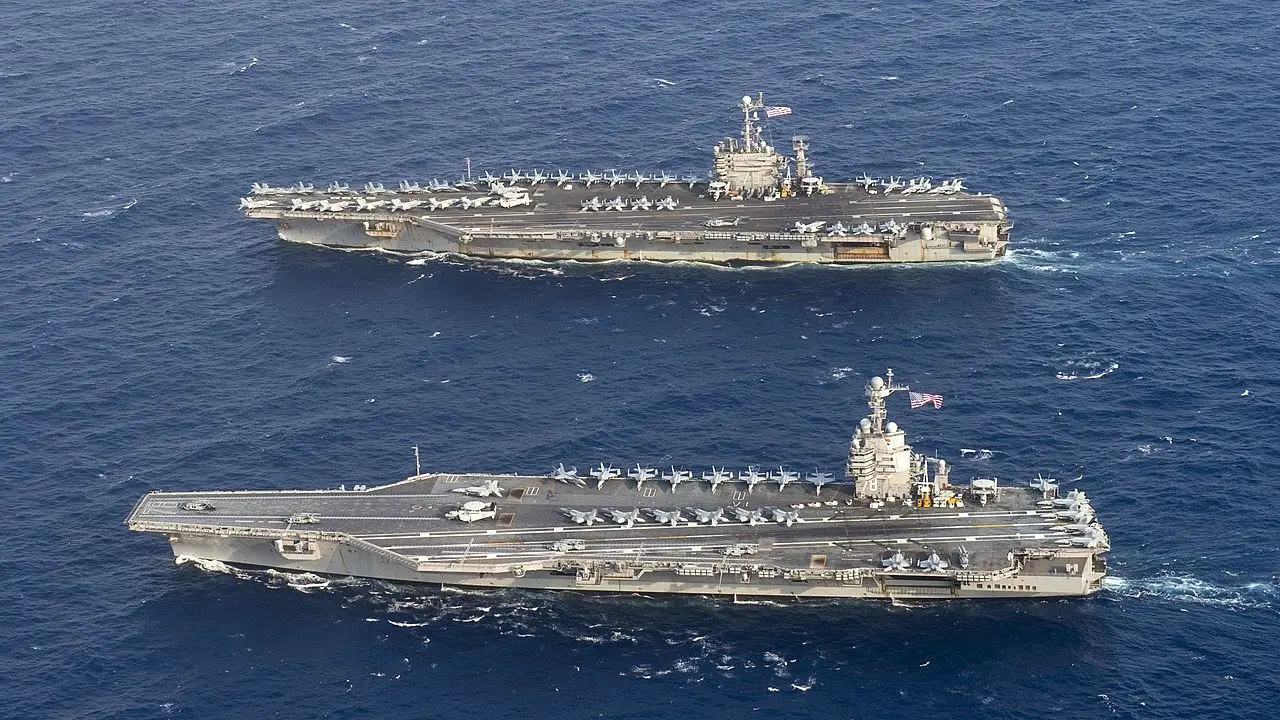In a major realignment of naval resources, the US Navy is facing a precarious situation in the Western Pacific as it redirects its assets to address rising tensions in the Middle East.
The move has left the Pacific region vulnerable. An aircraft carrier will not arrive until later this year when a newly refurbished vessel is set to arrive.
The USS Abraham Lincoln Carrier Strike Group, currently positioned near Guam as part of the US military’s presence in the Pacific, has recently been directed by Defense Secretary Lloyd Austin to proceed to the Middle East.
This redeployment is intended to bolster support for Israel amid escalating regional conflicts and Iran’s threats of retaliation following the assassination of Hamas leader Ismail Haniyeh in Tehran.
The USS Lincoln’s move to the Middle East to replace the USS Theodore Roosevelt—a carrier recently reassigned from Pacific duties—has led to what many media outlets are calling a “carrier gap” in the Western Pacific.
The Roosevelt had previously been stationed in the Pacific to fill in for the USS Dwight D. Eisenhower, which was deployed to the Red Sea but has since returned to the US.
The decision to redirect these carriers highlights a growing strategic focus on the Middle East, which, while crucial, has left the Western Pacific in a precarious position until the arrival of the aircraft carrier USS George Washington later this year.
Adding to the complexity, the USS Carl Vinson, initially expected to shift its focus after participating in the Rim of the Pacific exercise in Hawaii, will return to San Diego, according to Nikkei Asia, citing the US Navy Spokesperson.
This unexpected decision further underscores the growing concerns over the lack of immediate carrier presence in the Pacific. The US Navy’s plan to address this shortfall includes the upcoming arrival of the USS George Washington in Yokosuka, Japan.
However, the USS George Washington, undergoing a “hull swap” with the USS Ronald Reagan in San Diego, is anticipated to arrive in the Pacific this autumn.
Iran-Israel War: Is Pakistan Arming Iran With Nuclear-Capable Ballistic Missiles? Islamabad Responds
This ongoing “hull swap” process involves a significant crew exchange, with 350 sailors transitioning from the Reagan to the George Washington.
This strategic adjustment highlights the Navy’s challenge in balancing its commitments across multiple theaters of operation while maintaining its strategic posture in critical regions.
US Navy Faces Strategic Dilemma with Carrier Gap?
The recent redeployment of the USS Abraham Lincoln Carrier Strike Group has created a void in the US Navy’s presence in the Western Pacific, a region increasingly fraught with geopolitical tensions.
The change occurs as the US Navy’s long-standing supremacy faces challenges from a rising China, a bold Russia, and a North Korea that persists in testing its neighbors.
China, in particular, has been ramping up its naval activities, frequently conducting exercises near contested territories.
For instance, on August 7, in what appears to be a direct response to joint military drills by the US, Australia, Canada, and the Philippines, China’s Southern Theatre Command announced air and sea combat patrols near Scarborough Shoal in the South China Sea.
According to Chinese officials, these drills aimed to assess their “strike capabilities.” Additionally, US media argued that the lack of a US carrier presents not just a logistical issue but also a strategic weakness.

It provides Beijing an opportunity to underscore its claims that Washington cannot fully meet its military commitments in Asia, potentially undermining the credibility of US defense assurances to its regional allies.
However, experts told EurAsian Times that deploying a US aircraft carrier to the Middle East will not expose vulnerabilities in the region.
Miguel Miranda, a military analyst based in the Philippines, dismissed concerns that the absence of US Navy carriers would weaken US positions globally. He argued that such assumptions are “absurd,” as the US and China maintain diplomatic and leadership contacts, reducing the likelihood of direct conflict.
Miranda also noted that the US military presence in the Asia-Pacific remains robust, with a busy schedule of multinational exercises this year. He challenged the notion that US carriers are crucial for deterring Chinese provocations against US allies, asserting that their absence does not encourage Chinese “risk-taking.”
He explained that, in large-scale conflicts involving long-range missiles, carriers may not provide significant deterrence or protection, a risk that applies to Chinese carriers as well.
In a similar line, Shashank S. Patel, Defense, and Geopolitical expert, told EurAsian Times that West Asia, particularly Israel-Palestine, faces a higher risk of conflict compared to East Asia.
He pointed out, “In these tumultuous conditions, the US needs to balance its naval strength in the Middle East as its airpower is limited there. It is a riskier move for them to leave the Western Pacific vulnerable, but they will compensate for it with their 16 major Marine Corps, Army, Naval, and Air bases. Also, the Pentagon announced the prior deployment of unspecified fighter squadrons for the Pacific to fulfill emergency firepower.”
He noted that over 60% of the US Navy’s fleet is currently stationed in the Pacific. When needed, the fleet can quickly deploy to the Western Pacific to address threats. In the meantime, existing active bases are expected to effectively “deter any big mishap for their allies.”
He noted that the USS Abraham Lincoln’s absence from the Western Pacific might give China some tactical advantage and flexibility in personnel movements.
However, with approximately 750 US bases worldwide, including around 192 in Japan and South Korea, and a substantial force of 375,000 military personnel in the INDOPACOM region, the US has significant firepower to manage any potential conflict in the Western Pacific, according to the Patel.
F-16s “Sitting Ducks” For Russian MiG-31 Fighters? Putin Warns Of Consequences Over Fighting Falcons
That being said, the US Navy’s carrier fleet, the largest in the world with 11 carriers, is not without its constraints. Many of these carriers are either undergoing maintenance or returning from extensive deployments, leaving only a few ready for immediate action.
This shortage may also prompt discussions in Washington about potential adjustments to US carrier deployments. One possible solution involves stationing a carrier in the Mediterranean to ease the burden on the Navy’s global commitments.
A congressional source told Nikkei Asia that basing a carrier in a Mediterranean location, such as Greece, Italy, France, or Spain, could help maintain a balanced carrier presence in the Pacific and Mediterranean regions.
This concept recalls past arrangements from the early 1970s when the US maintained carrier strike groups in Japan and Greece. However, the arrangement with Athens was later abandoned due to a military coup.
Nonetheless, as global tensions continue to rise, the US Navy faces the critical task of effectively managing its limited carrier resources to address simultaneous threats across multiple regions.





